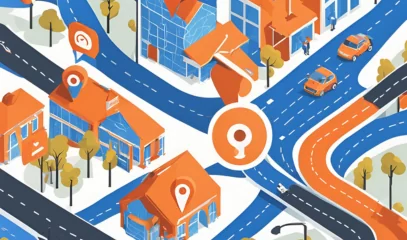Ranking on Google Maps is crucial for Toronto businesses looking to attract local customers. With most people searching for products and services on mobile devices, appearing in the top Google Maps results can significantly increase foot traffic, phone calls, and online engagement. A strong Google Maps presence combined with local SEO ensures your business stands out among competitors.
Key Takeaways:
- Optimize your Google Business Profile with accurate information and photos
- Use Toronto-specific keywords and neighborhood targeting
- Encourage customer reviews and respond professionally
- Leverage local citations and directory listings to boost credibility
- Track performance with analytics to refine your strategy
Why Google Maps Rankings Matter for Toronto Businesses
Google Maps rankings directly impact local visibility. Benefits include:
- Higher local visibility: Appear in local search results for “near me” queries
- Increased customer engagement: More calls, direction requests, and visits
- Improved credibility: A fully optimized profile signals trust to potential customers
- Cost-effective marketing: Organic Google Maps presence reduces reliance on paid ads
In a competitive Toronto market, appearing at the top of Maps search results can be a game-changer for small businesses.
Steps to Rank Your Toronto Business on Google Maps
1. Optimize Your Google Business Profile
Ensure your Google Business Profile includes:
- Correct business name, address, and phone number
- Hours of operation, including holidays
- High-quality photos of your business, products, or services
- A detailed business description with Toronto and neighborhood keywords
Book a free call to optimize your profile professionally.
2. Focus on Local Keywords
Use neighborhood-specific keywords like “coffee shop Yorkville Toronto” or “plumbing services near King Street West.” Include these in:
- Business description
- Service listings
- Website pages linked to your profile
3. Collect and Manage Reviews
Encourage satisfied customers to leave reviews and respond to all feedback professionally. Positive reviews improve trust and search rankings.
4. Leverage Local Citations and Listings
Submit your business to reputable directories and maintain consistent NAP (Name, Address, Phone) information across all platforms.
5. Create Localized Content
Write blogs or landing pages about Toronto neighborhoods, local events, or service areas. Linking these pages to your Google Business Profile strengthens local relevance.
6. Engage on Social Media
Sharing local news, events, or promotions on platforms like Instagram, Facebook, and Twitter supports your Google Maps ranking indirectly through engagement and traffic.
7. Monitor and Track Your Performance
Use Google My Business insights and Google Analytics to monitor:
- Profile views
- Clicks for directions
- Phone calls
- Website visits
Adjust your strategy based on what is driving the most engagement.
Advanced Strategies to Boost Google Maps Rankings
- Use Posts and Offers on Google Business Profile: Share promotions, events, or product highlights to engage users.
- Optimize for Voice Search: Include long-tail phrases like “best pizza near me in Toronto.”
- Build Local Backlinks: Collaborate with other Toronto businesses, sponsor events, or participate in community blogs to get backlinks.
- Add Frequently Asked Questions: Use Q&A on your profile to answer customer queries directly.
Book a free call to implement these advanced strategies.
Neighborhood-Specific Tips for Toronto
- Target high-traffic areas like Downtown Toronto, Yorkville, Queen Street West, and the Distillery District
- Include local landmarks in your descriptions, e.g., “Near CN Tower” or “Steps from St. Lawrence Market”
- Highlight community involvement to strengthen local relevance and trust
Frequently Asked Questions (FAQs)
1. How long does it take to rank on Google Maps?
It typically takes 2–6 months depending on competition, profile quality, and SEO efforts.
2. Can small Toronto businesses compete with large chains on Google Maps?
Yes, by optimizing Google Business Profile, targeting local keywords, and generating positive reviews.
3. How often should I update my profile?
At least monthly for photos, posts, and any changes in hours or services.
4. Do reviews affect Google Maps rankings?
Yes, both the number and quality of reviews are major ranking factors.
5. Can adding posts and offers improve visibility?
Absolutely. Regular posts keep your profile active and improve engagement metrics.
6. Are backlinks important for Google Maps?
Yes, local backlinks improve authority and relevance, boosting Maps rankings.
7. How do I measure my Google Maps performance?
Track insights like profile views, direction requests, website clicks, and phone calls.
8. Should I target multiple neighborhoods in Toronto?
Start with your primary area, then expand strategically to nearby neighborhoods for maximum impact.
Conclusion
Ranking your Toronto business on Google Maps requires a combination of profile optimization, local keyword targeting, review management, content creation, and community engagement. By following these strategies, small businesses can increase visibility, attract local customers, and compete effectively in Toronto’s competitive market.
Book a free consultation today or visit www.localbusinessmarketinghelp.com to start improving your Google Maps rankings and grow your Toronto business online.
